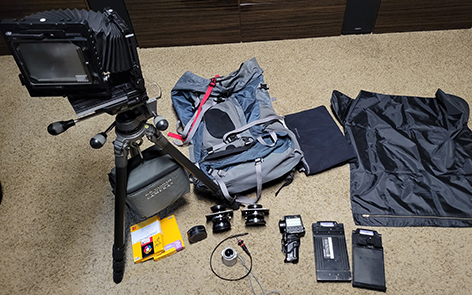
I felt it was time for another writing about my use of large format cameras. I realized it had been a while since my last writing on it. Last time was about why I enjoy shooting with a large format camera, and today I am going to talk about the equipment I use when I go out to take pictures.
As you may expect I use a camera manufactured by my father’s company (www.canhamcameras.com). I happen to use a DLC45. That is an all metal 4×5 camera. This happens to be a camera that I personally built while I worked for the company. For those that don’t know, the 4×5 means that the film size for this camera is 4 inches by 5 inches. Yes, I did say film. This is the smallest and lightest camera that the company builds, and that is one reason why I use it. I tend to go backpacking with my stuff so lighter is always better. I have used 5×7 and 8×10 before as well, and while I like the larger sizes in the film, I could never see myself using them full time since the added space and weight make them harder to hike with. It is a great camera and I love all the movements it has. It has more than enough bellows draw so I can use a wide range of lenses with no issue. It has front rise, fall, shift and tilt. It has rear tilt and shift as well. These movements allow me to compose my pictures just the way I want to. I can get nearly anything into the perspective I want. The camera also comes in a very nice bag (seen hanging from the tripod in the picture).
The camera requires the use of a tripod, and I happen to have a Gitzo G1348 for the legs which are actually my dad’s, but he has a couple sets so he is letting me use them on a permanent basis. They are carbon fiber and can get really tall if needed, but also collapse down small enough to fit in the backpack I use without any issue. For the tripod head I have a Gitzo G1570M. This is something I bought myself a while back (I think almost 20 years) because I wanted a good tripod head. I remember finding it on ebay for a good price. It will handle an 8×10 with no issue as well, so that is kind of cool. I happen to also use a Linhof quick release plate on my camera. It is a device that makes it faster to get the camera on and off the tripod.
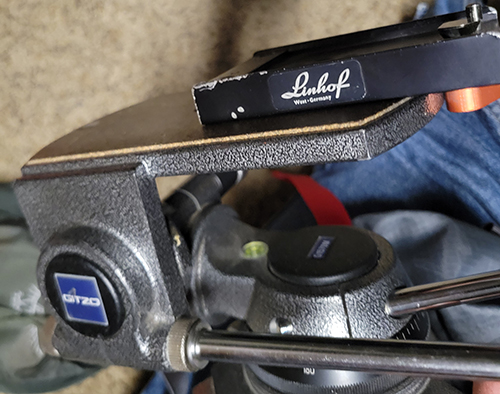
Next let’s talk about lenses. I use a few different lenses (as is typical for most large format photographers). I use a 90mm Schneider, a 180mm Nikkor, and a 300mm Rodenstock. The different lenses allow for different magnification. The longer the lens (bigger the number) the more magnified things are. This also means the less you see. And of course the shorter the lens (smaller number) the less magnified things are. This means you get a wider field of view (you see more). I like landscape photography so I find myself using shorter lenses more than longer lenses. I used a 210 Schneider for a long time, but I found that I really wanted something that was a bit wider, but not too much. Then my dad found the 180 and I have used it once and I really like it.
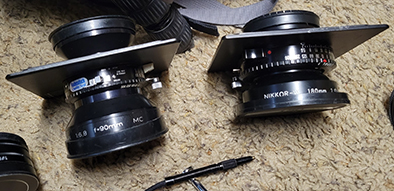

In combination with the lenses I also use filters at times. I quite often use a polarizing filter when I shot. This helps cut down on glare more than anything else, but sometimes it helps make the clouds “pop” from the sky. When I shoot black and white film I will sometimes use colored filters as well. These are filters I have borrowed from my dad as well. I have a red 25 and a yellow 12. What these do is that they allow less light to get to the film because they filter out all the light except the wavelength of the filter. So, with the red filter you cut out a lot of light. The blue sky goes very black (dark) and so the clouds will really come out. The yellow filter does less of that, but still can help create a different contrast that you wouldn’t get without the filter. I have also used neutral density filters a little bit, but not a lot. They have shaded areas on the filter and can help bring the light intensity down on part of the image so that the entire composition doesn’t have too large of a range of light exposure. This can help not have too white whites or too dark darks.
Next I have a light meter. I happen to have a Sekonic Dual Spot meter. I really like this meter and it is something I purchased for myself when I first started using a large format camera. I like being able to move around the area that I am going to take a picture of and take readings of specific sections so I can decide how to expose my image.
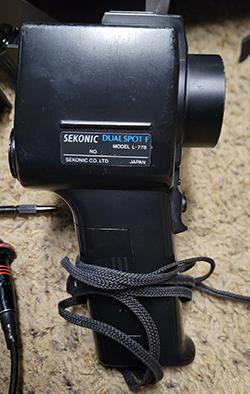
I also have a very nice 6x Schneider loop (the silver looking thing in the picture at the top). This is used to magnify a section of the ground glass (where you look to see the image formation) to check for focus. I was given this loop by Uli, a Vice President at Schneider, a long time ago at one of the PhotoKina conventions I went to with my father. It is a really nice loop.
Then there is film. I have used Fuji, Kodak, and Ilford over the years. I like Ilford HP5+ for my black and white work, but I have also used Kodak Tmax and Tri-X. For color I used a lot of Fuji Velvia for a number of years because I had someone give me a bunch of it. I like the way the colors come out on that film. It is a color positive film, and that is one reason it does that so well. Recently I have been using Kodak Portra for my color images mostly because I have easy access to it and that color negative film is easy to get developed.
For carrying the film I don’t usually use the typical film holder. I was blessed with a Fuji Quick Change holder when I first started shooting. This holder you can see below holds 8 sheets of film in a cartridge. It takes up far less room than having to carry 4 regular holders (each regular holder holds 2 sheets of film). What I tend to do is carry one cartridge with color film and one with black and white film. Then as I take pictures I can unload the film if I need to along the way and reload. But typically 8 sheets of each type of film is enough when I go on a trip where I plan to take pictures.
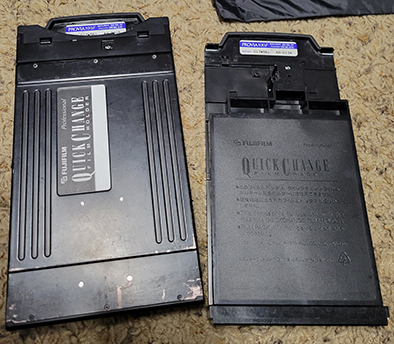
The other important thing you need is a darkcloth. My wife made me my darkcloth a long time ago. It works really well, but is a bit bulky. She has offered to make me a new one, but I need to get her the material for it, and I have just been too lazy to do it. But I really need to do it. Another thing is a change bag. That is a light tight bag so I can change the film in the film holders without the film being exposed to unwanted light. I always carry one with me just in case I need it for one reason or another (and I have needed it a few times when I had equipment malfunction with the quick change holder). Both of these can be seen in the picture at the top (Darkcloth is folded black thing, and the Change Bag is the opened black thing with arm holes next to it).
Finally, I have a large Osprey hiking backpack that I use when I go out (again check out the picture at the top). It isn’t perfect for getting stuff out once it is in the bag since you have to access it all from the top, but I really like the way the backpack sits on me when it is fully loaded and when hiking. That is a big plus. Typically I will have up to 40 lbs of equipment and water on me when I go out. So, having a good fitting backpack is a must in my opinion. This backpack holds everything I listed above without any trouble (and a couple of empty film boxes to hold exposed film and some boxes with unexposed film in case I need to change film along the way), and even has a bit of extra space.
So there you have it. That is my setup for a typical outing. My next writing (wherever that comes) will be about what I take pictures of and why. At least that is my plan. Who knows for sure. I have a trip planned in March where I plan to take pictures so I may do a blog about that trip and the pictures I took on the trip first.